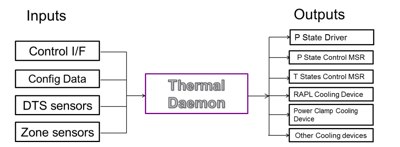Intel’s Open Source Technology Center has released an open source tool to monitor and control temperature in tablets, ultrabooks and laptops. The Linux Thermal Daemon can use the latest thermal drivers in the Linux kernel, not just the standard cpufreq subsystem, to provide CPU temperature control.
Due to constrained system size, small form factor devices reach their maximum temperature with relatively less load than desktops and servers. And as they get smaller and thinner, traditional cooling methods such as heat sinks and fans are being designed out of the devices. Developers can’t rely only on hardware and BIOS to regulate temperature without negatively impacting performance.
Thermal Daemon “proactively tries to limit the temperature so BIOS doesn’t take a drastic action to cool the system,” said Srinivas Pandruvada, the Thermal Daemon project lead in the Open Source Technology Center at Intel. “The hardware and BIOS can (regulate) itself but it’s usually not an optimal solution, depending on their implementation. And, if the temperature reaches critical point, it can  result in powering down of the system. ”
result in powering down of the system. ”
Tapping Intel Drivers for Temperature Control
The Linux kernel already holds a number of power management drivers that regulate temperature and cooling in various ways and rely on ACPI configuration to use them. But there are new cooling drivers developed by Intel, for which the device must first ask the driver to take action. The Thermal Daemon tool manages cooling drivers, either through preconfigured or custom settings.
“Developers can access XML configuration files and specify what level of temperature and what cooling drivers they want to use,” Pandruvada said. “But for most developers, the default settings and cooling actions should be enough.”
By tapping into the latest kernel drivers such as Intel P-State , RAPL (running average power limit) and PowerClamp, Thermal Daemon allows developers to more precisely control the temperature set point for a given use case.
However, not all of the above drivers are accessible to all hardware. The Intel P-state drivers are specific to the new generation Sandy Bridge and Ivy Bridge processors, for example.
“If the latest drivers are not available, then the daemon will revert to x86 model specific registers and the Linux ‘cpufreq subsystem’ to control system cooling,” according to the Intel news release.
Download and Get Involved
This is the first code release since the Thermal Daemon project kicked off in December, so the driver hasn’t been incorporated yet into any distributions. Intel is actively looking for feedback and features for consideration in future versions, Pandruvada said.
Thermal Daemon can also be applied to other computing form factors such as mobile and server, but is being targeted initially towards the tablet and laptop segments.
Download the Thermal Daemon source code and documentation from the Open Source Technology Center at https://01.org/linux-thermal-daemon


